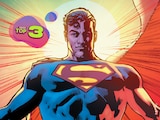SPOILER ALERT: The following contains mild spoilers from The New Gods #1.
Jack Kirby’s New Gods is my favorite comic of all time (alongside Hellblazer and Denny O’Neil and Neal Adams’s Green Lantern/Green Arrow), and part of what I love about it is how specific the world and characters feel to the 1970s. Through characters like Orion and Mister Miracle, I can see Kirby, a combat veteran of World War II, trying to negotiate between the violence of his youth, his sense of justice and his desire for peace as an older man. For me, New Gods is a window into the minds of a generation who are no longer with us.
With this in mind, I was absolutely floored by how Ram V and Evan Cagle made these characters in The New Gods #1 feel contemporary, all without changing their essential DNA. By the time I reached the last page of the issue, I had goosebumps. It made me think that this is what it must have been like to read Kirby’s original New Gods when the issues were coming out in the early 1970s. The ambitious scope, breathtaking artistry and devastating premise of Ram and Cagle’s story make The New Gods #1 more than a worthy successor to Kirby’s original series. I’m a little emotional!

The New Gods #1 picks up in the aftermath of the DC All In Special, where Darkseid ripped the fabric of the multiverse. Now, Darkseid is dead and his planet of Apokolips no longer has a ruler. His absence is felt even on New Genesis, the paradise world that exists in opposition to Apokolips. Sensing a new imbalance in the wake of Darkseid’s death, New Genesis’s leader, Highfather, commands Orion to go to Earth and kill a New God who will upset the balance even further. The only problem? This emergent New God is a baby. For the first time in his long life, Orion feels conflicted by his devotion to Highfather.
I really love how Ram V brings a sense of emotional intimacy to key figures in the New Gods pantheon. Highfather, for instance, has traditionally stood in gentle but stoic contrast to the loud and brash emotions of his adopted son, Orion. But here, under Ram’s pen, Highfather is broken inside, and it’s an appropriate development for someone who traded away his own son (Mister Miracle) to Darkseid. The original premise of Kirby’s New Gods was audacious enough, and it’s satisfying to see a writer tackle the emotional echoes of their world all these years later.

Evan Cagle’s artwork subtly works in symphony with this echoing theme. One of the most haunting pages in all of DC Comics for me is from Kirby’s New Gods #7, when Granny Goodness delivers an infant Mister Miracle to Darkseid. You’re immediately struck by how angelic, yet helpless, the baby looks. In this issue, take a look at the “World’s Greatest Escape Artist” banner that fills the background of a panel during Mister Miracle and Orion’s conversation. The banner features curly-haired cherubs that resemble baby Scott in New Gods #7. It’s clear in both Ram’s writing and in Cagle’s artwork that that original Kirby page had an impact on them, too.
Beyond Mister Miracle, Cagle’s referential artwork plays with the central duality between Darkseid and Highfather, Apokolips and New Genesis. Towards the beginning of the issue, as Highfather gazes into the void of space, Cagle draws him with a sense of benign melancholy. But after Highfather learns of the infant New God on Earth and decides to send Orion to kill them, his face falls into an expression of stern ruthlessness we’ve never seen from him before. The wrinkles and shadows on his face become more pronounced, his mouth curling into a cruel line. In that moment, Highfather looks a lot like Darkseid. It’s a disturbing but effective choice that is echoed later on when Orion uses the Mother Box to remind Mister Miracle of his “true face.” With Orion’s New Genesis features melting away into the calcified mass revealing his parentage, is it Highfather who he resembles in this panel or Darkseid?

Orion has always been a character rooted in the debate between nature versus nurture, and Cagle breaking down the visual distinctions between Highfather and Darkseid leaves us with a set of distressing questions. Was this a false dichotomy all along? If Orion chooses to reject the values of both his adoptive and biological fathers, then who will he become? Can Darkseid ever be truly dead if he lives on in the thoughts and actions of others?
I’m glad that The New Gods #1 is full of haunting moments like these because it shows just how strong Ram V and Evan Cagle’s storytelling prowess is, as well as their intimate understanding of the characters. Fatherhood is a persistent theme in so many DC stories, but the New Gods have always offered a unique meditation on it. With Mister Miracle now a father and Orion questioning his loyalty to Highfather, Ram V and Evan Cagle have laid the groundwork for The New Gods to devastate us all. And I am so here for it.
The New Gods #1 by Ram V, Evan Cagle, Jorge Fornés and Francesco Segala is now available in print and as a digital comic book.
Jules Chin Greene writes about comics, TV, games and film for DC.com, and his work can also be found at Nerdist, Popverse and Multiverse of Color. You can follow him on Bluesky at @JulesChinGreene and on Instagram at @infinitevibes.
NOTE: The views and opinions expressed in this feature are solely those of Jules Chin Greene and do not necessarily reflect those of DC or Warner Bros. Discovery, nor should they be read as confirmation or denial of future DC plans.















